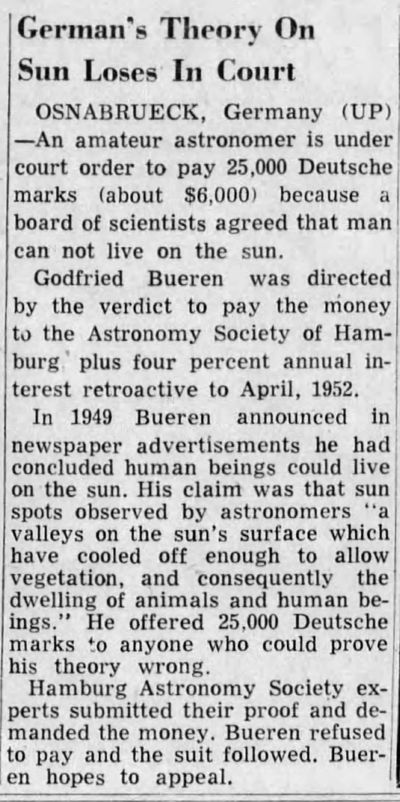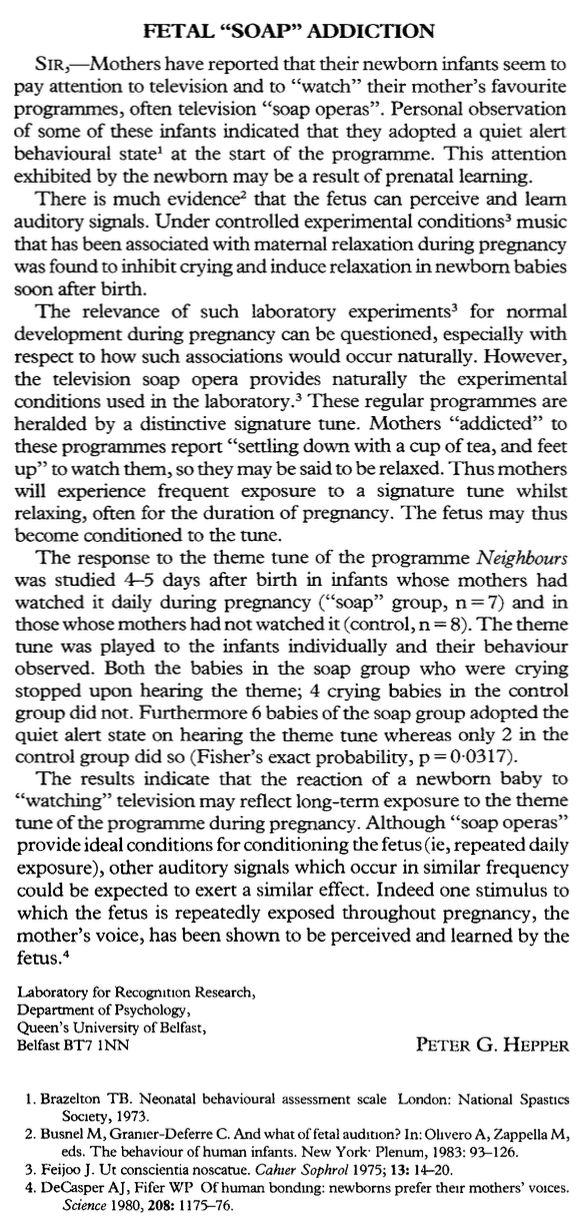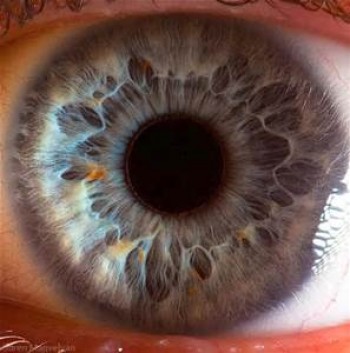Science
Scientist who thought women were like apes
The wikipedia article on Oxford anthropologist Arthur Thomson (1858-1935) notes that he's best remembered for formulating Thomson's Nose Rule, which states that ethnic groups from cold climates tend to have thinner noses than groups from hot climates.Apparently he's not remembered for his "Women Are Like Apes" theory, which he presented to a meeting of the Royal Academy of Sciences in 1927. The basis of this theory was that, "woman's legs are usually shorter, and her arms longer, than man's" — and this, Thomson felt, made women more ape-like.
I was curious whether Thomson was actually correct about female body proportions, and after some googling I've concluded that he probably was — at least about women (on average) having shorter legs as a proportion of their total height than men do. See, for instance, this article by a designer of bicycles for women, which says that's the case.

Harrisburg Telegraph - Oct 5, 1927
Posted By: Alex - Sat Jun 25, 2016 -
Comments (6)
Category: Science, Anthropology, 1920s, Women
Seven Ways Frogs Mate

Our knowledge of how frogs get sexy together continues to expand. It used to be that we knew of only six frog mating positions, but now a seventh has been added to the repertoire, thanks to the efforts of University of Delhi researchers who "spent a few dozen nights filming the sex lives of Bombay night frogs."
The new position, which involves no genital contact, is called the "dorsal straddle":
Over at National Geographic they helpfully provide a chart of all seven positions.

Posted By: Alex - Wed Jun 15, 2016 -
Comments (2)
Category: Nature, Science
Court rules sun uninhabitable
Godfried Bueren of Germany declared that there were areas on the sun cool enough to support human life. He offered 25,000 marks to anyone who could prove him wrong. So the Hamburg Astronomical Society sent him a list of reasons why he was wrong. When Bueren refused to pay, the society took him to court. In 1953, the court ordered him to pay up.
Palm Beach Post - Mar 22, 1953
More info in Time - Feb 23, 1953:
Through years of spare-time dabbling in such occult sciences as prophecy and mental telepathy, Godfried Bueren, 70, a West German patent attorney, never lost his amateur enthusiasm for astronomy. Finally, he announced, he had learned something that professional astronomers don't know. The sun, asserted Herr Bueren is a hot, hollow sphere, a million miles in diameter; inside its fiery shell floats a cool core, 600,000 miles thick and lush with vegetation. What's more, he had 25,000 marks ($5,945) that said he was correct about the sun.
When Herr Bueren announced his startling theory, most scientists shrugged it off. But the German Astronomical Society accepted the challenge. Said Hamburg Observatory Director Otto Heckmann: the society would like to keep such "silly ideas" from attracting too much attention. Besides, the society needed the money.
Like schoolmasters marking a poor student's test paper Dr. Heckmann and a couple of scientists sharpened their pencils and set to work on Herr Bueren's theory. The sun's corona does blaze at approximately 1,000,000° C., they conceded, but who can believe that the enormous heat is caused, as Herr Bueren also insisted, by cosmic particles striking the sun's outer atmosphere? Why shouldn't the same particles bombard the earth and set it glowing? And did Herr Bueren really believe that sunspots are gaping holes in the sun's shell, opening on to a cool black core where plant life changes heat into chemical energy, thus lowering the temperature? Pure nonsense, said the scientists. As for heat-reducing plants: Dr. Heckmann & Co. pointed out that science knows of no plants that use up all the energy available to them.
A Bueren-picked jury of West German scientists studied the astronomical society's arguments and solemnly announced the the Bueren solar theory had been demolished. His bald pate flushed with anger, the sun-gazing patent attorney refused to pay. "People who want to cash in on the money," he cried, "do not even pay attention to what I have to say."
But Dr. Heckmann and colleagues, having paid attention to the prize offer, sued Bueren in the Osnabruck court. "Science cannot always say what is correct." they argued, "but we have advanced so far as to be able to say what is wrong."
Last week, despite Herr Bueren's dark mutterings that his professorial jury had been intimidated, the court found the sun's core legally hot, ordered him to hand over the 25,000 marks plus a year's interest at 4% and court costs.
Posted By: Alex - Tue Jun 14, 2016 -
Comments (6)
Category: Eccentrics, Science, 1950s
Fetal Soap Addiction
June 1988: Australian researcher Peter Hepper reported in the medical journal The Lancet that fetuses often appeared to learn to recognize the theme tune of their mother's favorite soap opera. As a newborn baby, hearing this tune would then calm them down.He tested this hypothesis by playing the theme tune of the Australian soap "Neighbours" to a group of newborns whose mothers watched the show. Upon hearing it, he reported, six of the seven babies promptly adopted a "quiet alert state."

The Lancet - June 11, 1988

Des Moines Register - June 29, 1988
Posted By: Alex - Tue Jun 07, 2016 -
Comments (4)
Category: Science, Experiments, Television, 1980s
The Production of Warts by Suggestion

Gravitz wasn't actually doing this himself, but he reported that back in the early 20th century (and presumably earlier as well) creating warts was a popular pasttime among girls in the Swiss canton of Vaud:
He noted that such practices were a form of amusement among the Vaudois girls who derived pleasure from passing their own warts on to someone else. "A ribbon is tied around the affected hand, and is knotted as many times as there are warts on the hand; then the ribbon is dropped on the highway. Whoever picks it up and unties the knots, will get the warts, and the original owner of the warts will be cured."
Posted By: Alex - Mon Jun 06, 2016 -
Comments (9)
Category: Science, Psychology, Skin and Skin Conditions
Three-Winged Chickens
1950: Scientists at UCLA breed three-winged chickens. More buffalo wings on one bird!
Herald and News (Klamath Falls, Oregon) - Nov 9, 1950

The Eugene Guard - Nov 15, 1950
Posted By: Alex - Thu Apr 21, 2016 -
Comments (9)
Category: Animals, Science, Experiments, 1950s
The Science of Craps
If this is true, I assume the effect isn't significant enough to overcome the house advantage.
St. Louis Post-Dispatch - Sep 7, 1937
Posted By: Alex - Sun Apr 10, 2016 -
Comments (9)
Category: Science, 1930s, Gambling, Casinos, Lotteries and Other Games of Chance
True Legend

Andres Ruzo grew up with the story of the boiling river as told to him by his grandfather. Later, as a geoscientist, he decided to try and validate the legend. The Boiling River: Adventure and Discovery in the Amazon is the story of how, as a man, he proved the legend that captivated him as a boy.
Posted By: Alex - Wed Feb 17, 2016 -
Comments (5)
Category: Geography and Maps, Science, Books, Myths and Fairytales
The MRE Diet
Army researchers are conducting a study to try to improve the healthfulness of MREs (meals, ready-to-eat), and they're looking for volunteers.To qualify to participate, you need to live near Natick, Massachusetts and be willing to eat MREs (and nothing but MREs) for 21 days.
But the researchers say the lack of variety won't really be that bad because they've managed to come up with a book of recipes using only MRE ingredients. Recipes include "everything from specialty beverages ('Canteen Irish Cream Latte') to main dishes ('Bunker Hill Burritos') to desserts ('Fort Bliss-ful Pudding Cake')."
More info: Army Times.

Posted By: Alex - Thu Dec 31, 2015 -
Comments (5)
Category: Food, Military, Science
Seeing The Light

For those who wish to recover their sight promising research is being done by the Universities of Bern, Switzerland and Gottingen, Germany. The process is called Optogenetic therapy and is expected to help those who have lost their sight due to some degenerative diseases of the eyes. Certain proteins are inserted into cells in the retina causing those cells to sense light. The effected cells then act in place of the light sensing cell that were destroyed by the disease process. This treatment has already been successful in returning sight to mice. It is not a cure for all blindness but it is certainly a great step forward in treating blindness due to degenerative diseases. There seems to be a long way to go before it will be ready for human use but the journey has at least begun.
Posted By: Alex - Fri Oct 02, 2015 -
Comments (2)
Category: Science, Universities, Colleges, Private Schools and Academia, Eyes and Vision

| Who We Are |
|---|
| Alex Boese Alex is the creator and curator of the Museum of Hoaxes. He's also the author of various weird, non-fiction, science-themed books such as Elephants on Acid and Psychedelic Apes. Paul Di Filippo Paul has been paid to put weird ideas into fictional form for over thirty years, in his career as a noted science fiction writer. He has recently begun blogging on many curious topics with three fellow writers at The Inferior 4+1. Contact Us |




